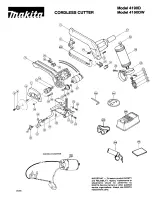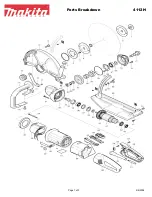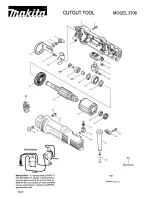
10
GENERAL SAFETY RULES
The most important safety device for this or
any tool is the operator. Care and good judg-
ment are the best protection against injury.
· All possible hazards cannot be covered here,
but we have tried to highlight some of the
important items, individuals should look for
and obey Caution, Warning and Danger signs
placed on equipment, and displayed in the
workplace.
• DO NOT operate or service this equipment
before reading the entire manual.
This equipment should not be operated by per-
sons under 18 years of age.
• NEVER operate this equipment without prop-
er protective clothing, shatterproof glasses,
steel-toed boots and other protective devices
required by the job.
• NEVER operate this equipment when not
feeling well due to fatigue, illness or taking
medicine.
• NEVER operate this equipment under the in-
fluence or drugs or alcohol.
• NEVER use accessories or attachments, which
are not recommended by our company for this
equipment. Damage to the equipment and/or
injury to user may result.
• The manufacturer does not assume responsi-
bility for any accident due to equipment modi-
fications.
• Whenever necessary, replace nameplate, op-
eration and safety decals when they become
difficult to read.
• ALWAYS check the machine for loosened
threads or bolts before starting.
• NEVER touch the hot exhaust manifold, muf-
fler or cylinder. Allow these parts to cool be-
fore servicing engine or saw.
• High Temperatures-Allow the engine to cool
before adding fuel or performing service and
maintenance functions. Contact with not com-
ponents can cause serous bums.
The engine section of this cutter requires an
adequate free flow of cooling air.
WARNING: RISK OF EXPLOSION OR FIRE.
• Fuel and its vapors are extremely flammable
and explosive. Fire or explosion can cause se-
vere burns or death.
· ALWAYS shut off engine and allow it to cool a
least 2 minutes before adding fuel to the tank.
· ALWAYS use care in filling tank to avoid spill-
ing fuel. Move machine away from fueling
area before starting engine.
· ALWAYS Keep maximum fuel level below top
of tank to allow for expansion.
· ALWAYS operate and fuel equipment in well
ventilated areas free from obstructions. Equip
areas with fire extinguishers suitable for gaso-
line fires.
· ALWAYS Store fuel in an OSHA approved con-
tainer, in a secure location away from work
area.
• Failure to follow instructions in this manual
may lead to serious injury or even death! This
equipment is to be operated by trained and
qualified personnel only!
This equipment is
for industrial use only.
DANGER: CARBON MONOXIDE HAZARD.
• Running engine gives off carbon monoxide,
an odorless, colorless, poison gas. Breathing
carbon monoxide can cause nausea, fainting
or death. Some chemicals or detergents may
be harmful if inhaled or ingested, causing se-
vere nausea, fainting or poisoning.
· ALWAYS Keep exhaust gas from entering a
confined area through windows, doors, venti-
lation intakes, or other openings.
· NEVER operate unit in a location occupied by
humans or animals.
· ALWAYS follow manufacturers recommenda-
tions, use a respirator or mask whenever there
is a chance that vapors may be inhaled.
• Whenever necessary, replace nameplate, op-
eration and safety decals when they become
difficult read.
• Manufacturer does not assume responsibility
for any accident due to equipment modifica-
tions.
• NEVER use accessories or attachments, which
are not recommended for this equipment.
Damage to the equipment and/or injury to
user may result.
• NEVER touch the hot exhaust manifold, muf-
fler or cylinder. Allow these parts to cool be-
fore servicing engine or machine.
• ALWAYS stop the engine before servicing,
adding fuel and oil.
• NEVER run engine without air filter. Severe
engine may occur.
• ALWAYS service air cleaner frequently to pre-
vent carburetor malfunctions.
CCO820 manual.indd 10
17/10/17 10:00






































